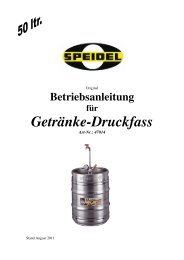Operating and brewing instructions 50l april 2008 - Speidel Tank
Operating and brewing instructions 50l april 2008 - Speidel Tank
Operating and brewing instructions 50l april 2008 - Speidel Tank
Create successful ePaper yourself
Turn your PDF publications into a flip-book with our unique Google optimized e-Paper software.
<strong>Speidel</strong>’s Master Brewer<br />
Maltose mode<br />
During the maltose mode, which is the second phase, the molecules of starch are<br />
converted into fermentable sugar with the aid of other enzymes that are present in the<br />
malt. This phase is an important stage of the <strong>brewing</strong> process for forming alcohol<br />
because the greatest amounts of sugar are formed during it. Extending the mode means<br />
gaining more sugar in the wort, which lead to a stronger beer. Shortening the time<br />
means that the beer will be more full-bodied on account of more dextrines. The<br />
temperature is approximately 63°C <strong>and</strong> it will be maintained for a duration of<br />
approximately 35 minutes. As in Phase 1, the controls show the relevant data in the<br />
display. The complete further process (Phase 2 to Phase 5) is h<strong>and</strong>led completely<br />
automatically by the controls. In this phase <strong>and</strong> also in the following phase, the pump<br />
is switched off briefly twice (PUMP PAUSE), in order to move the malt into a new<br />
position <strong>and</strong> thereby achieve a better yield. The Master Brewer’s lid is on in order to<br />
save energy.<br />
Saccharifaction mode 1<br />
Other starchy constituents are split up with the aid of active molecules in this<br />
temperature level during the third mashing phase <strong>and</strong> they are liquefied in the wort.<br />
The temperature level is approximately 73°C <strong>and</strong> will also be maintained for 35<br />
minutes.<br />
Saccharification mode 2<br />
Residual starches are saccharified in the final phase <strong>and</strong> they thus form even more<br />
unfermentable extracts, which allow the beer to become somewhat more full-bodied.<br />
The wort is heated up to 78°C while doing so <strong>and</strong> with continuously pumped<br />
recirculation: it has to be held there for between 10 <strong>and</strong> 20 minutes. An iodine test can<br />
be used to establish whether any residual starch is still present in the wort. Put some<br />
drops of wort on a white plate <strong>and</strong> add some salt for this purpose. The saccharification<br />
will be sufficient if the sample turns brownish red or yellow. If that is not the case,<br />
then the last temperature level must be held longer. In the last phase, no more pump<br />
pauses will take place because of clarification of the wort.<br />
4.5 Running off<br />
End of phase<br />
quit<br />
Remove malt pipe<br />
quit<br />
On completion of the programme <strong>brewing</strong> phases, a signal<br />
tone again sounds. This must also be acknowledged by<br />
pressing ENTER. The pump switches off, <strong>and</strong> the so-called<br />
‘running-off’ process is requested (“Remove malt pipe”). One<br />
describes the separation of crushed malt from the beer wort as<br />
‘running off’. Running off with the Master Brewer is a<br />
relatively easy, quick <strong>and</strong> clean matter compared with many<br />
other methods of domestic <strong>brewing</strong> <strong>and</strong> it represents one of the<br />
Master Brewer’s main concepts. Remove the wing nut together<br />
with the holding-down stirrup. The draining stirrup is laid on<br />
the <strong>brewing</strong> boiler’s rim: the malt pipe is then pulled carefully<br />
<strong>and</strong> slowly out of the boiler with the lifting stirrup. One hangs<br />
the malt pipe in the holding stirrup on the lower supporting bolts, so that the beer wort<br />
drains out of the malt into the boiler. One can still leach the last residues of extracts by<br />
washing out the malt husks subsequently with an aftermash. One describes the process<br />
as ‘sparging’ (the process is not absolutely necessary). The so-called ‘sparging’ takes<br />
place by pouring in hot water at 78 °C (no boiling water) into the malt pipe from<br />
Page 9 of 26
















